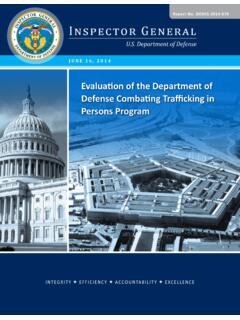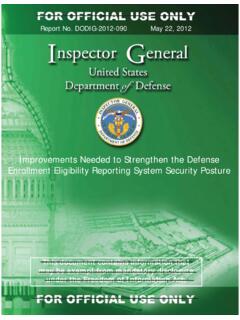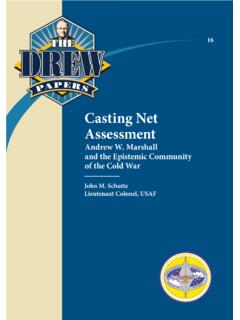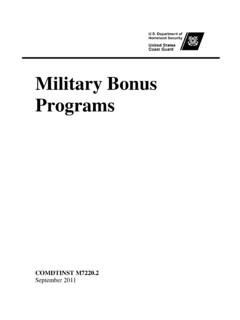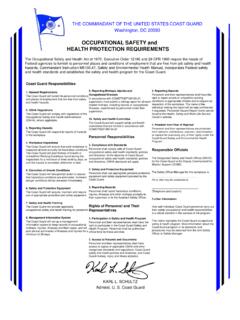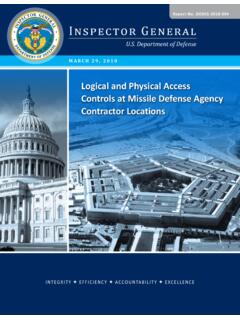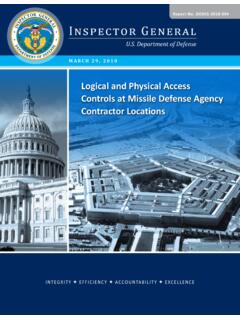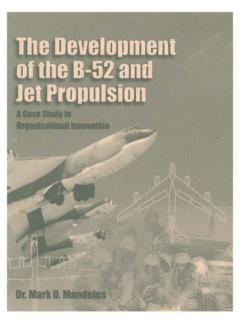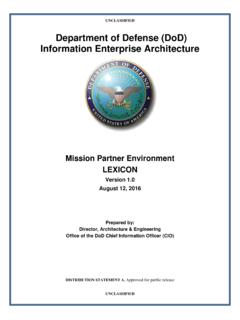Transcription of Assessing and Strengthening the Manufacturing and …
1 UNCLASSIFIED UNCLASSIFIED. Assessing and Strengthening Base and Supply Chain Resiliency of the United States Assessing and Strengthening the Manufacturing and defense Industrial the Manufacturing and defense Industrial Base and Supply Chain Resiliency of the United States Report to President Donald J. Trump by the Interagency Task Force in Fulfillment of Executive Order 13806. September 2018. Office of the Under secretary of defense for Acquisition and Sustainment Office of the Deputy Assistant secretary of defense for Industrial Policy UNCLASSIFIED UNCLASSIFIED. Assessing and Strengthening the Manufacturing and defense Industrial Base and Supply Chain Resiliency of the United States UNCLASSIFIED. Contents I. Executive Summary .. 1. II. Introduction .. 7. III. Methodology .. 11. IV. An Overview of America's Manufacturing and defense Industrial Base .. 15. The Domestic Manufacturing and defense Industrial Base .. 16. The Global Manufacturing and defense Industrial Base.
2 16. V. Five Macro Forces Driving Risk into America's Industrial Base .. 19. 1. Sequestration and Uncertainty of Government Spending .. 20. 2. Decline of Manufacturing Capabilities and Capacity ..24. 3. Deleterious Government Business and Procurement Practices .. 32. 4. Industrial Policies of Competitor Nations .. 34. 5. Diminishing STEM and Trade Skills ..42. VI. Ten Risk Archetypes Threatening America's Manufacturing and defense Industrial Base .. 45. 1. Sole Source ..46. 2. Single Source .. 47. 3. Fragile Supplier .. 47. 4. Fragile Market .. 48. 5. Capacity Constrained Supply Market .. 48. 6. Foreign Dependency ..49. 7. Diminishing Manufacturing Sources and Material Shortages ..49. 8. Gaps in Human 9. Erosion of 10. Product Security .. 51. VII. A Blueprint for Action .. 53. Current Efforts .. 53. Future Efforts and Recommendations .. 54. Appendix One: Executive Order 13806 .. 59. Appendix Two: Sector Summaries .. 63. Traditional defense Sectors.
3 64. Cross-Cutting Sectors .. 87. Appendix Three: Contributing Government Agencies .. 105. i UNCLASSIFIED. Assessing and Strengthening the Manufacturing and defense Industrial Base and Supply Chain Resiliency of the United States UNCLASSIFIED. Appendix Four: Government Sources .. 111. Appendix Five: Industry Listening Sessions .. 119. Appendix Six: Agreements with Foreign 121. Photo Credits .. 125. Endnotes .. 129. ii UNCLASSIFIED. Assessing and Strengthening the Manufacturing and defense Industrial Base and Supply Chain Resiliency of the United States UNCLASSIFIED. I. Executive Summary Requirement On July 21, 2017, President Donald J. Trump signed Executive Order (EO) 13806 on Assessing and Strengthening the Manufacturing and defense Industrial Base and Supply Chain Resiliency of the United States. The EO directs the secretary of defense to conduct a whole-of-government effort to assess risk, identify impacts, and propose recommendations in support of a healthy Manufacturing and defense industrial base a critical aspect of economic and national The EO 13806 effort was initiated by the White House Office of Trade & Manufacturing Policy led by the Department of defense 's Office of Industrial Policy in coordination with the Departments of Commerce, Labor, Energy, and Homeland Security, and in consultation with the Department of the Interior, the Department of Health and Human Services, the Director of the Office of Management and Budget, the Director of National Intelligence, the Assistant to the President for National Security Affairs, the Assistant to the President for Economic Policy, and the Assistant to the President for Trade & Manufacturing Policy.
4 America's Manufacturing and defense industrial base ( the industrial base ) supports economic prosperity and global competitiveness, and arms the military with capabilities to defend the 1 UNCLASSIFIED. Assessing and Strengthening the Manufacturing and defense Industrial Base and Supply Chain Resiliency of the United States UNCLASSIFIED. nation. Currently, the industrial base faces an unprecedented set of challenges: sequestration and uncertainty of government spending; the decline of critical markets and suppliers;. unintended consequences of Government acquisition behavior; aggressive industrial policies of competitor nations; and the loss of vital skills in the domestic workforce. Combined, these challenges or macro forces erode the capabilities of the Manufacturing and defense industrial base and threaten the Department of defense 's (DoD) ability to be ready for the fight tonight, and to retool for great power competition. The following report explains the macro forces impacting the industrial base, identifies primary categories of risk, illustrates impacts within sectors, and provides recommendations for mitigation.
5 Methodology The EO 13806 assessment evaluated risk based on current and planned operating priorities as of late 2017/early 2018. An Interagency Task Force, led by DoD, created sixteen working groups with over 300 subject matter experts from across the federal government. Nine working groups focused on traditional sectors; seven working groups assessed enabling, cross-cutting capabilities (Figure 1). Figure 1: List of Traditional and Cross-Cutting Sectors These macro forces collectively represent the root causes of ten risk archetypes distributed throughout the industrial base. The working groups identified discrete impacts within their sectors, many of which fall under more than one risk archetype, as illustrated in Figure 2. 2 UNCLASSIFIED. Assessing and Strengthening the Manufacturing and defense Industrial Base and Supply Chain Resiliency of the United States UNCLASSIFIED. Figure 2: Macro Forces Map to Risk Archetypes Findings The risk framework used for the EO 13806 effort evolved from the working groups' assessments of their sectors.
6 The assessment identified: Five macro forces shaping industrial base-wide trends and causing a deterioration in capabilities;. Ten risk archetypes resulting from the macro forces, each of which contribute to insecurity in DoD's supply chain;. Over 280 impacts across sectors, acutely affecting the vitality and resiliency of the industrial base.*. Major findings include: Macro forces have led to impacts primarily in the sub-tiers of the defense supply chain;. A surprising level of foreign dependence on competitor nations exists;. Workforce challenges face employers across all sectors; and Many sectors continue to move critical capabilities offshore in pursuit of competitive pricing and access to foreign markets. *A classified spreadsheet provides a comprehensive list of impacts across risk archetypes for fifteen sectors;. due to its proliferation across sectors, the software engineering working group assessed impacts across all sectors.
7 3 UNCLASSIFIED. Assessing and Strengthening the Manufacturing and defense Industrial Base and Supply Chain Resiliency of the United States UNCLASSIFIED. Recommendations The DoD-led Interagency Task Force recognizes ongoing efforts to address the challenges identified in the EO 13806 assessment, including: Increased near-term DoD budget stability with the passage of the Bipartisan Budget Act of 2018, providing stable funding through Fiscal Year (FY) 2019. Modernization of the Committee on Foreign Investment in the and investigations under Section 301 of the Trade Act of 1974 into Chinese intellectual property theft, to better combat Chinese industrial policies targeting American intellectual property Updates to the Conventional Arms Transfer policy and unmanned aerial systems export policy to increase industrial base competitiveness and strengthen international alliances Reorganization of the former Office of the Under secretary of defense for Acquisition, Technology and Logistics, the work of the Section 809 panel, and development of the adaptive acquisition framework all aim to streamline and improve defense acquisition processes Restructuring the defense Acquisition University to create a workforce education and training resource to foster increased agility in acquisition personnel Response to Section 1071(a)
8 Of the National defense Authorization Act for FY2018 which requires establishing a process for enhancing the ability to analyze, assess, and monitor vulnerabilities of the industrial base Creation of a National Advanced Manufacturing Strategy by the White House Office of Science and Technology Policy, focused on opportunities in advanced Manufacturing Department of Labor's chairing of a Task Force on Apprenticeship Expansion to identify strategies and proposals to promote apprenticeships, particularly in industries where they are insufficient DoD's program for Microelectronics Innovation for National Security and Economic Competitiveness to increase domestic capabilities and enhance technology adoption DoD cross-functional team for maintaining technology advantage Implementation of a risk-based methodology for oversight of contractors in the National Industrial Security Program, founded on risk management framework principles to assess and counter threats to critical technologies and priority assets In addition to the ongoing efforts outlined above, the DoD-led Interagency Task Force created a set of recommendations aligned to four levers: investment, policy, regulation, and legislation.
9 The recommendations are organized by the secretary , with DoD's recommendations provided in a classified Action Plan. In summary, the recommendations propose: Create an industrial policy in support of national security efforts, as outlined in the National defense Strategy, to inform current and future acquisition practices 4 UNCLASSIFIED. Assessing and Strengthening the Manufacturing and defense Industrial Base and Supply Chain Resiliency of the United States UNCLASSIFIED. Expanding direct investment in the lower tier of the industrial base through DoD's defense Production Act Title III, Manufacturing Technology, and Industrial Base Analysis and Sustainment programs to address critical bottlenecks, support fragile suppliers, and mitigate single points-of-failure Diversifying away from complete dependency on sources of supply in politically unstable countries who may cut off access; diversification strategies may include reengineering, expanded use of the National defense Stockpile program, or qualification of new suppliers Working with allies and partners on joint industrial base challenges through the National Technology Industrial Base and similar structures Modernizing the organic industrial base to ensure its readiness to sustain fleets and meet contingency surge requirements Accelerating workforce development efforts to grow domestic science, technology, engineering, mathematics (STEM), and critical trade skills Reducing the personnel security clearance backlog through more efficient processes Further enhancing efforts to explore next generation technology for future threats A challenge this large demands a multifaceted approach.
10 Therefore, the classified Action Plan also includes direction for DoD to conduct a comprehensive study on the industrial base requirements needed to support force modernization efforts, specifically focused on the technologies necessary to win the future fight. 5 UNCLASSIFIED. Assessing and Strengthening the Manufacturing and defense Industrial Base and Supply Chain Resiliency of the United States UNCLASSIFIED. This page intentionally blank. 6 UNCLASSIFIED. Assessing and Strengthening the Manufacturing and defense Industrial Base and Supply Chain Resiliency of the United States UNCLASSIFIED. II. Introduction It would, also, be a material aid to manufactures of this nature, as well as a mean of public security, if provision should be made for an annual purchase of military weapons, of home manufacture, to a certain determinate extent, in order to the formation of arsenals; and to replace, from time to time, such as should be drawn for use, so as always to have in store the quantity of each kind which should be deemed a competent supply.
